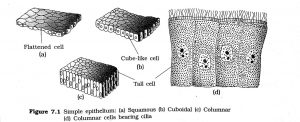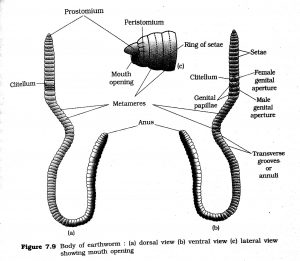Study Notes on Structural Organization of Animals
ANIMAL TISSUES
- The structure of the cells vary according to their function. Therefore, the tissues are different and are broadly classified into four types: (i) Epithelial, 2) Connective, (iii) Muscular and (iv) Neural.
- Epithelial Tissue We commonly refer to an epithelial tissue as epithelium- This tissue has a free surface.
- These faces either a body fluid or the outside environment and thus provides a covering or a lining for some part of the body.
- The cells are compactly packed with little intercellular matrix.
- There are two types of epithelial tissues namely simple epithelium and compound epithelium.
- Simple epithelium is composed of a single layer of cells and functions as a lining for body cavities, ducts, and tubes.
- The compound epithelium consists of two or more cell layers and has protective function as it does in our skin.
- The squamous epithelium is made of a single thin layer of flattened irregular boundaries. They are found in the walls of blood vessels Boundary.

- The cuboidal epithelium is composed of a single layer of a)squamous b) Cuboidal (c) Concave-like cells.
- This is commonly found in ducts of glands and tubular parts of nephrons in kidneys and its main functions are secretion and absorption.
- The epithelium of proximal convoluted tubule (PCT) of nephron in the kidney has microvilli. The columnar epithelium is composed of a single layer of tall and slender cells.
- Their nuclei are located at the base. Free surface may have microvilli.
- They are found in the lining stomach and intestine and help in secretion and absorption.
- If the columnar or cuboidal cells bear cilia on their free surface they are called Ciliated epithelium.
- Their function is to move particles or mucus in a specific direction over the epithelium.
- They are mainly present in the inner surface of hollow organs like bronchioles and fallopian tubes.
- Some of the columnar or cuboidal cells get specialised for secretion and are called glandular epithelium.
- They are mainly of two types: unicellular, consisting of isolated glandular cells. And multicellular, consisting of cluster of cells (salivary gland).
- On the basis of the mode of pouring of their secretions, glands are divided into two categories namely exocrine and endocrine glands.
- Exocrine glands secrete mucus, saliva, earwax, oil, milk, digestive enzymes and other cell products.
- These products are released through ducts or tubes. In contrast, endocrine glands do not have ducts.
- Their products called hormones are secreted directly into the fluid bathing the gland.
- Compound epithelium is made of more than one layer (multi-layered) of cells and thus it has a limited role in secretion and absorption.
- Their main function is to provide protection against chemical and mechanical stresses.
- They cover the dry surface of the skin, the moist surface of buccal cavity, pharynx, inner lining of ducts of salivary glands and of pancreatic ducts.
- Three types of cell Junction are found in the epithelium and other issues. These are called as it adhering and gap Junctions.
- Tight Junctions help to stop substances from leaking across a tissue.
- Adhering Junctions perform cementing to keep neighbouring cells together.
- Gap junctions facilitate the cells to communicate with each other by connecting the cytoplasm of adjoining cells, for rapid transfer of ions, small molecules and sometimes big molecules.
CONNECTIVE TISSUE
- Connective tissues are most abundant and widely distributed in the body of complex animals.
- They are named connective tissues because of their special function of linking and supporting other tissues/organs of the body.
- The range from soft connective tissue to specialised types which include cartilage bone adipose and blood.
LOOSE CONNECTIVE TISSUE.
- These are cells and fibers loosely arranged in a semi fluid ground substance
- Adipose tissue is one of example of loose connective tissues located mainly beneath the skin.
- Areolar tissue is another example of these tissues.
DENSE CONNECTIVE TISSUE.
- These are fibres and fibroblasts are compactly packed in the dense connective tissue.
- In the dense regular and dense irregular, connective tissue the collagen fibers are present in rows between many parallel boundaries.
BONES.
- Bones have a hard and non- pliable ground substance rich in calcium salt collagen fibers.
- These provide strength and frame work to the body.

BLOOD.
- Blood is a fluid connective tissue containing plasma, red blood cells, white blood cell, and platelets.
- The main circulating fluid that helps in the transportation of various substance.
MUSCLE TISSUE.
- The muscle is made of many long cylindrical fibres arranged in parallel arrays.
- These fibres are composed of numerous fine fibrils, called myofibrils.
- Muscle fibres contract (shorten) in response to stimulation, then relax (lengthen) and return to their uncontracted state in a coordinated fashion.
- Their action moves the body to adjust to the changes in the environment and to maintain the positions of the various parts of the body.
- In general, muscles play an active role in all the movements of the body.
- Muscles are of three types, skeletal, smooth, and cardiac.
- Skeletal muscle tissue is closely attached to skeletal bones.
- In a typical muscle such as the biceps, striated (striped) skeletal muscle fibres are bundled together in a parallel fashion.
- A sheath of tough connective tissue encloses several bundles of muscle fibres also stimulated to contract.
- The smooth muscle fibres taper at both ends (fusiform) and do not show strations Cell functions hold them together and they are bundled together in a connective tissue sheath.
- The wall of internal organs such as the blood vessels, stomach and Intestine contains this type of muscle tissue Smooth muscles are involuntary as their functioning cannot be directly controlled.
- Cardiac muscle tissue is a contractile tissue present only in the heart.
- Cell functions fuse the plasma membranes of cardiac muscle cells and make them stick together Communication junctions (Intercalated discs) at some fusion points allow the cells to contract as a unit.
- when one cell receives a signal to contract, its neighbours are also stimulated to contract.
NEURAL TISSUE
- Neural tissue exerts the greatest control over the body’s responsiveness to changing conditions.
- The neuroglia cell which constitute the rest of the neural system protect and support
- neurons Neurogtia make up more than one half the volume of neural tissue in our body.
- When a neuron is suitably stimulated. an electrical disturbance is generated which swiftly travels along its plasma.
ORGAN AND ORGAN SYSTEM
- The basic tissues mentioned above organise to form organs which in tum associate to form organ systems in the multicellular organisms.
- Such an organisation is essential for more efficient and better coordinated activities of millions of cells constituting an organism.
- Each organ in our body is made of one or more type of tissues.
- Heart consists of all the four types of tissues, i.e., epithelial, connective, muscular and neural.
EARTHWORM
- Earthworm is a reddish brown terrestrial invertebrate that inhabits the upper layer of the moist soil.
- During day time, they live in burrows made by boring and swallowing the soil.
- In the gardens, they can be traced by their faecal deposits known as worm castings.
- The common Indian earthworms are Pheretima and Lumbricus.
MORPHOLOGY
- Earthworms have long cylindrical body. The body is divided into more than hundred short segments which are similar (metameres about100-120 in number).
- The dorsal surface of the body is marked by a dark median mid dorsal line (dorsal blood vessel) along the longitudinal axis of the body.
- The ventral surface is distinguished by the presence of genital openings (pores). Anterior end consists of the mouth and the prostomium.
- A lobe which serves as a covering for the mouth and as a wedge to force open cracks in the soil into which the earthworm may crawl.
- The prostomium is sensory in function. The first body segment is called the peristomium (buccal segment) which contains the mouth. In a mature worm.
- The segments 14-16 are covered by a prominent dark band of glandular tissue called clitellum.
- the body is divisible into three prominent regions – preclitellar, Clitellar and postelltellar segments.
- The Four pairs of spermathecal apertures are situated on the ventro-lateral sides of the intersegmental grooves, i.e., 5h-gth segments.
- A single female genital pore is present in the mid-ventral line of 14th segment.
- A pair of male genital pores are present on the ventro-lateral sides of the 18th
- Numerous minute pores called nephridiopores open on the surface of the body.
- In each body segment, except the first, last and Clitellum, there are rows of S-shaped setae, embedded in the epidermal pits in the middle of each segment.
- The Setae can be extended or retracted, Their principal role is in locomotion.

COCKROACH
- Cockroaches are brown or black bodied animals that are included in class Insecta of Phylum Arthropoda, Bright yellow, red and green coloured cockroaches have also been reported in tropical regions.
- Their size ranges from 4 inches to 3 inches (0.6-7.6 cm) and have long antenna, legs and flat extension of the upper body wall that conceals head.
- They are nocturnal omnivores that live in damp places throughout the world.
- They have become residents of human homes and thus are serious pests and vectors of several diseases.
MORPHOLOGY
- The adults of the common species of cockroach, Periplaneta americana.
- These are about 34-53 mm long with wings that extend beyond the tip of the abdomen in males.
- The body of the cockroach is segmented and divisible into three distinct regions – head, thorax and abdomen The entire body is covered by a hard chitinous exoskeleton (brown in colour).
- In each segment, exoskeleton has hardened plates called sclerites (tergites dorsally and sternites ventrally) that are joined to each other by a thin and flexible articular membrane (arthrodial membrane)

